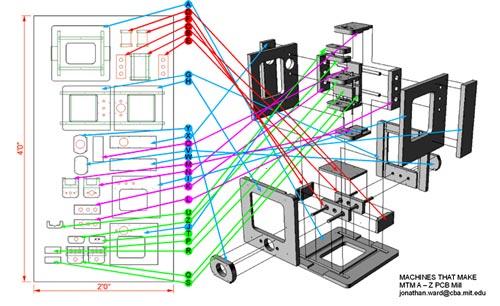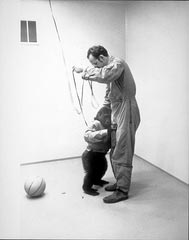HOW
TO MAKE (ALMOST)
ANYTHING
contact
// irina
chernyakova
1
[0912]
FINAL
PROJECT PROPOSAL
2
[0919]
COMPUTER
CONTROLLED CUTTING
3
[0926] ELECTRONICS
PRODUCTION
4
[1003]
COMPUTER
CONTROLLED MACHINING
5
[1010]
FINAL
PROJECT UPDATE
6
[1017]
MOLDING
/ CASTING / COMPOSITES
7
[1024]
EMBEDDED
PROGRAMMING
8
[1031]
3D
SCANNING + PRINTING
9
[1107]
INPUT
DEVICES
10[1114]
OUTPUT
DEVICES
11[1121]
INTERFACE
+ APPLICATION PROGRAMMING
12[1128]
MECHANICAL
+ MACHINE DESIGN + FINAL PROJECT UPDATE 13[1205]
NETWORKING
+ COMMUNICATIONS 14[1212]
FINAL
PROJECT DEVELOPMENT 15[1219]
FINAL
PRESENTATIONS
1
archive[-al
machine]
For
the final project, I'd like to make an physical archive for the work
completed in this class. Reflecting on the semester, we've learned so
many different things. Coming in with no background in electronics or
programming, I'd like to use the final project as an opportunity to
re-work some of the projects from the semester in the form of an
archive. Think of as [How to Make Almost Anything, in a box] or [the
idiot's guide to how to make almost anything.]
prior
art:
NATURAL
HISTORY + CURIOSITY CABINETS



RE-INTERPRETED;
DISPLAY FOR GLASS-BLOWN SPECIMENS / SCULPTURAL CROCHET DISPLAY


PHYSICAL
/ DIGITAL RE-INTERPRETATIONS; CABINET W/ RFID TAGS

 VIDEO
HERE
VIDEO
HERE
LED
ARRAY TYPECASE / SUDOKU (click on the image for original page)




Also,
found this class from Carnegie
Mellon: Making Things Interact. Assignment 5 was Curiosity
Cabinets, some interesting interpretations...
The
archive[-al] machine is a press-fit physical archiving system;
made to display and teach the viewer about basic concepts of
fabrication.
 +
+




Step
1 is
to evaluate the projects from each week, and decide on an overall
thematic. Having produced a first iteration of all the projects, and
considering everything I have learned thus far, I will re-produce the
work for each week. I'd like to start with 3D printing and casting;
and I've already started to re-make some of the eagle boards for the
pcb's from various weeks, (images from last week) so these, along
with instructions can be incorporate as well.
GOAL
1: is
to complete the press-fit structure, along with the embedded LEDs,
and code.
- figure out how the containers assemble or fold into
each other and press fit joints
- what kind of LEDs, PCB with
sensor and LED in each container? Or LEDs + sensor, central
control.
GOAL
2: is
to complete at least (1) week's worth of material, beginning with
casting/printing.
MATERIALS:
basic:
1/4”
PLEXI for press-fit
Light sensors + LEDs (equal number, one for
each week's container)
consider
week specific:
1
– laser cut
2 – producing the FABtiny
3 – shopbot and/or
waterjet
…
2
mtm
This
week the class also assembled an MTM, a machine that makes a machine.
Designed by Jonathan Ward and Nadya Peek, the MTM is a inexpensive
mini-milling machine; another version of the Roland Modela. David
Costanza held a session on preparing the Partworks files; quite
incredible to simply see the layout – all the parts necessary for
the machine on two sheets of 18x36 material. I helped Emma and Akane
finish cutting last minute, and unfortunately only caught the end of
the assembly session as I had to watch this wonderful
[kidding,
actually one of the most gruesome, painful, disturbing films I have
ever seen; yet incredibly interesting] film, PRIMATE,
for another class.


 happiest
Makers you have ever seen?
happiest
Makers you have ever seen?




[PRIMATE
presents
the daily activities of Yerkes Primate Research Center. Scientists in
the film are concerned with studying the physical and mental
development of primates. Some of the experimental work shown in the
film deals with the capacity to learn, remember, and apply language
and manual skills; the effect of alcohol and drugs on behavior; the
control of aggressive and sexual behavior; and other neural and
physiological determinants of behavior. Review:
PRIMATE
ostensibly has to do with the routine investigations of primate life
and behavior (notably sexual behavior) which are conducted at the
Yerkes Primate Research Center in Atlanta. What it’s actually about
is scientific research: its seemingly accepted presence in American
life, and its ambiguous purposes. –Michael
Arlen, The New Yorker]






 VIDEO
HERE
VIDEO
HERE














